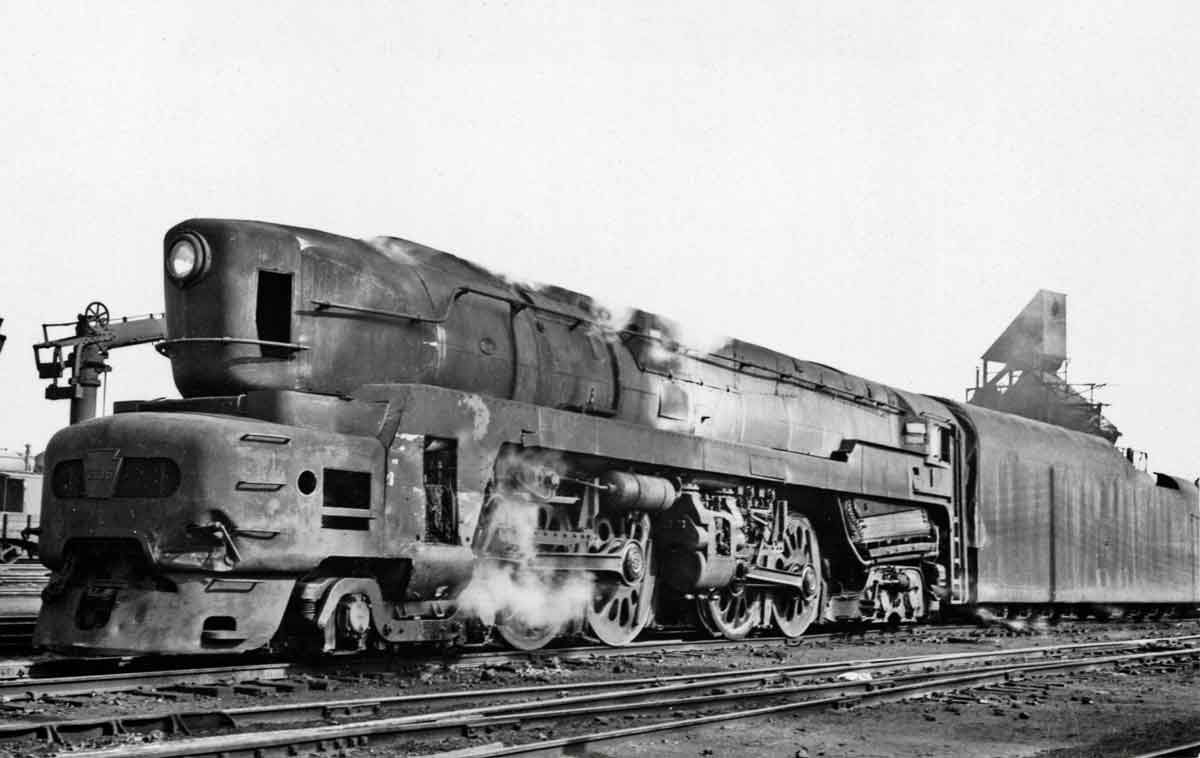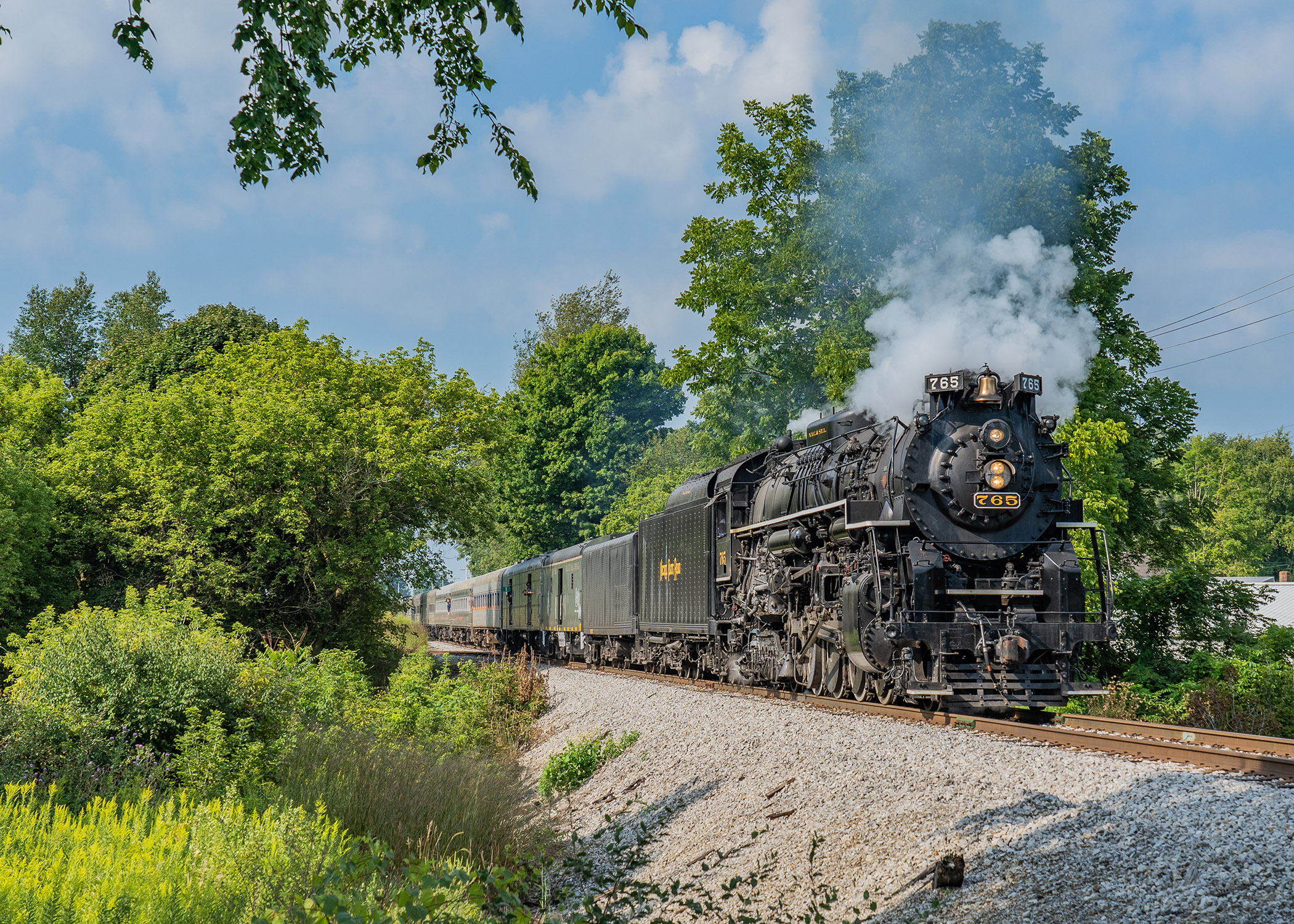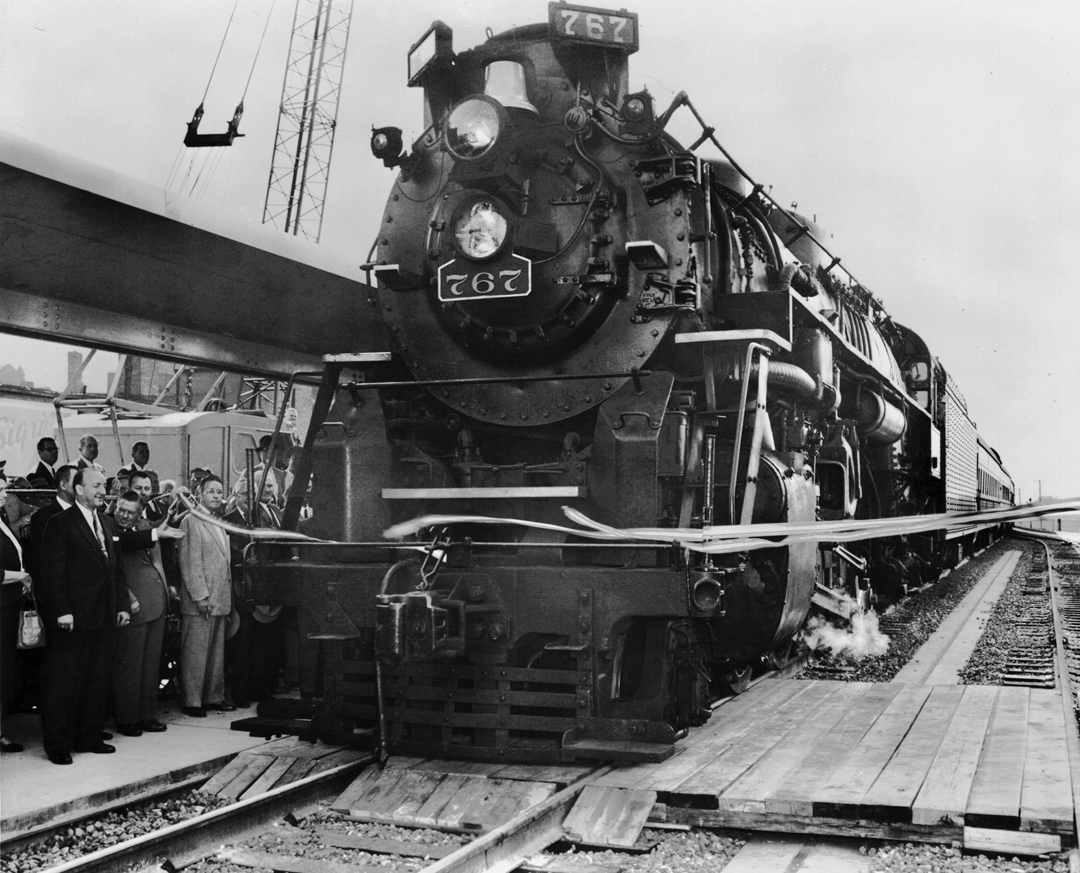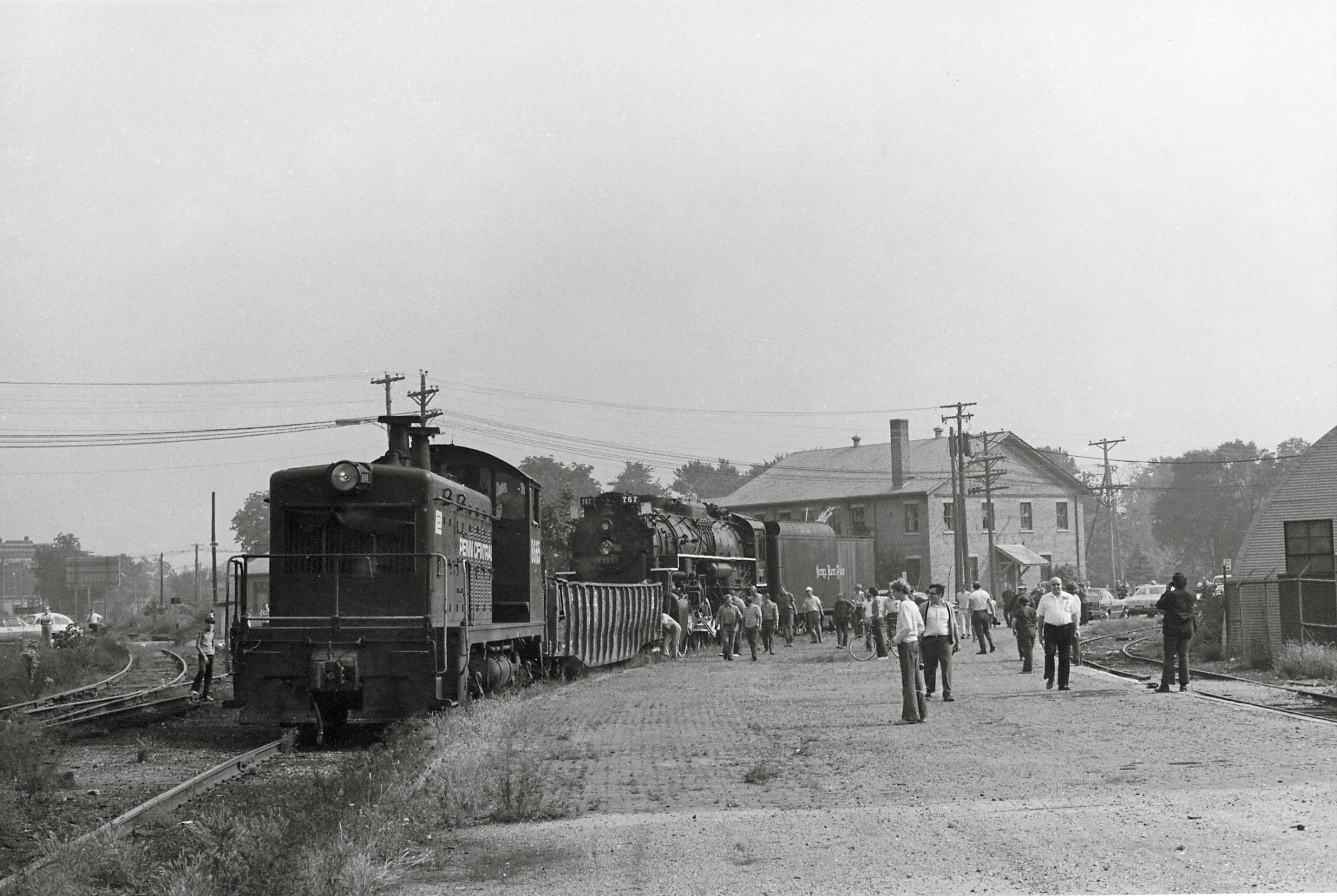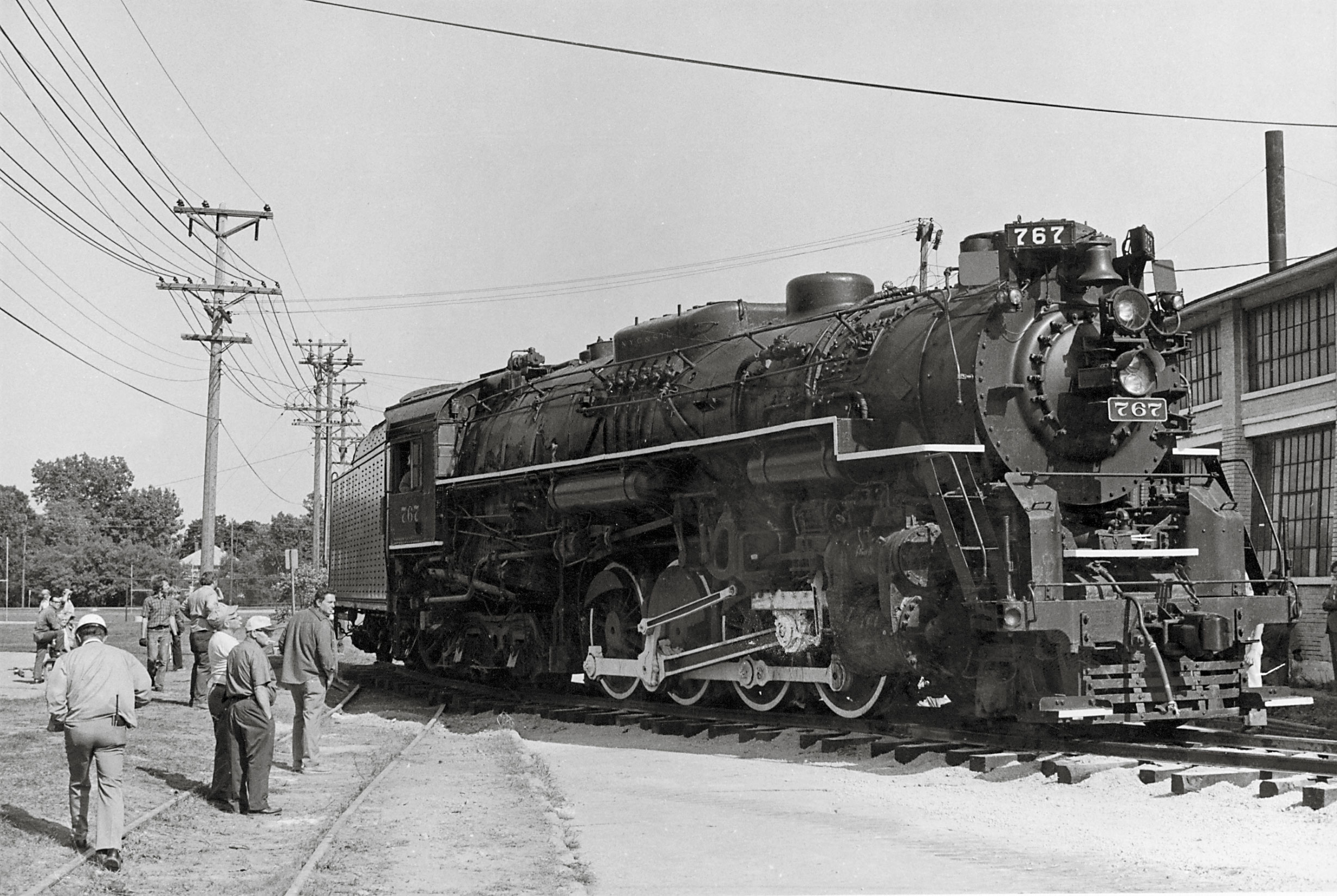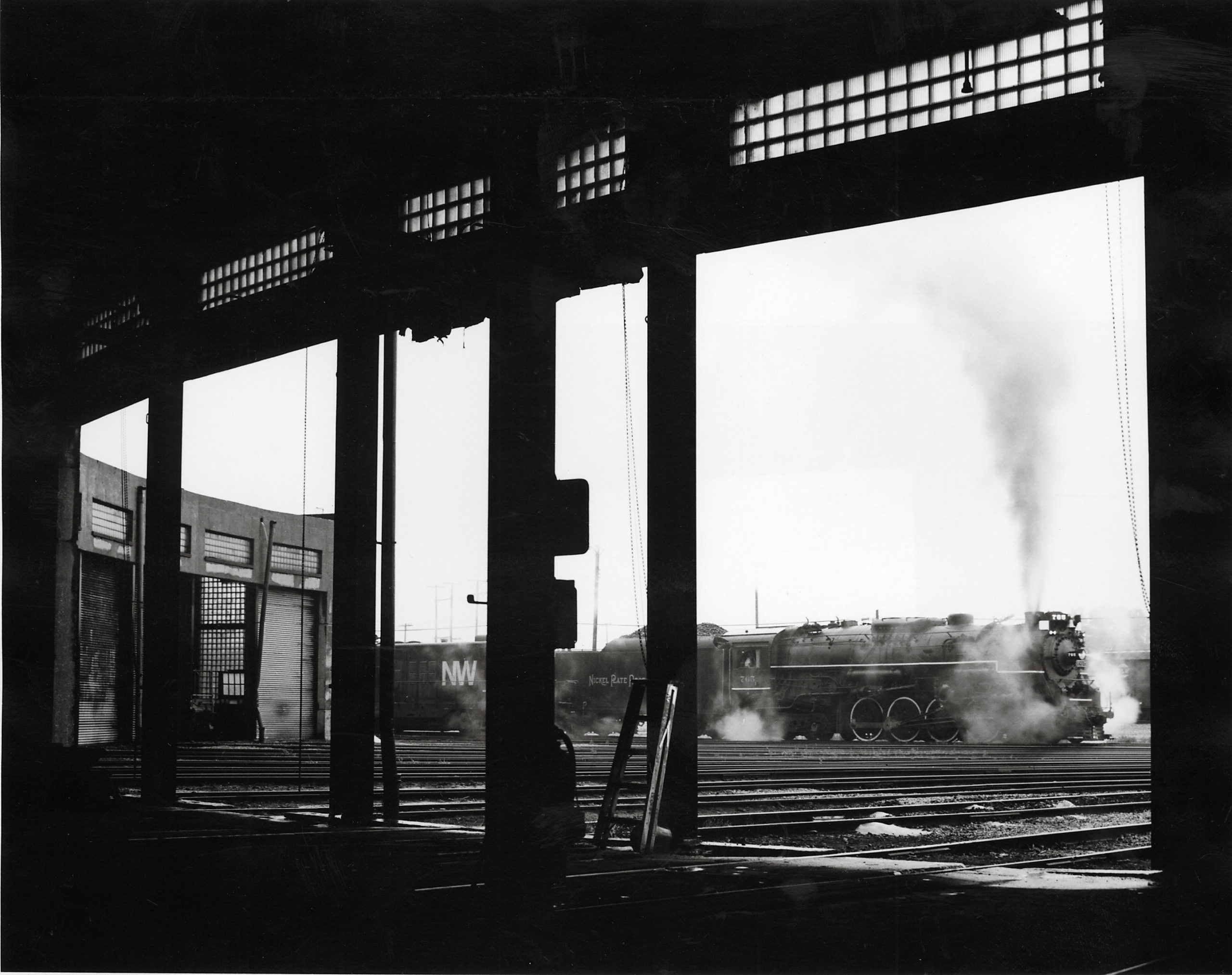Perhaps the most repeated story of a PRR T1 came from Pennsy fireman John Crosby:
Early in 1948, Pennsylvania Railroad (PRR) President Martin W. Clement announced that "by May of this year we expect all our important east-west passenger trains will be diesel-electric powered west of Harrisburg."
True to his word, hordes of pin-striped diesels began to arrive from La Grange, Eddystone, Erie, and any other place that could slap together a diesel locomotive. It seems that the Pennsy, in its rush to dieselize, bought them all.
With the arrival of the new power, it was not long before the Pennsy's T1 Locomotives, then only three or so years old were relegated to pulling secondary trains. I was firing such a run between Fort Wayne, Indiana and Crestline, Ohio, and return. Even our unglamorous trains, many bereft of names, now regularly sported diesels on the head end.
The best evidence of this was the way passenger engine crews dressed for work. Most of us had discarded our work shirts, overalls, and bandanas in favor of slacks and sport shirts. Some of the old-timers persisted in wearing their Oshkosh or Carhartt overalls, but they were looked down upon as hopeless fossils by we of the younger crowd.
While I had joined the slacks and shirt crowd, in the bottom of my grip I still carried a pair of goggles and gauntlet gloves.
On the day in question, my engineer and I were awaiting the arrival of No. 43. The train was due into Crestline at 2:25 p.m., and was a typical secondary train of that era. The normal consist was about 14 cars of storage mail, Railway Express, and Railway Post office cars, a combination car and two coaches. The train originated in Pittsburgh and wound up in Chicago, making stops every 25 miles of so. On this run, the only significant revenue was produced on the head end, not in the coaches.
About 1:45 p.m. we received word that number 43 was running some 45 minutes late, and was steam powered. We were being assigned a class T1, and would we kindly get ourselves on the No. 5536.
Reluctantly we walked out of the roundhouse and searched for our engine. Way over on a back ready track we found it.
What a pitiful sight! The engine and tender were coated with thick layers of grime and soot. At any place where steam was discharged, either by design or accident, streaks of gray dripped downward. Someone had cleaned off the numbers on the side of the cab. This had been done in such a fashion that each number looked as though it was in an oval frame. To verify ownership, the flanks of the tender proudly displayed the letters PENNSY. The LVANIA was totally covered by dirt. The rubber diaphragm between the cab and tender was in shreds or missing. On the engine, various inspection covers were missing, giving it a curiously hollow appearance. The casing around the stacks was gone and they showed up quite clearly.
I had anticipated the cab would not be very clean so I scrounged up a large ball of cotton waste. Climbing up into the cab confirmed my suspicions that it was a filthy mess. About the only clean spot was the engineer's seat where the hostler had sat while coaling up the tender. Harry, my engineer, using the privileges of seniority, remained on the ground and hollered up to me to get him a long oil can. I handed him one and began to get busy with my cleaning. It was quite evident that this engine had been sitting around for some time with the cab windows open to the elements and whatever dirt happened to be in the area.
I turned on the injector, then the squirt hose, and tried to wash down all the dirt that I could dislodge with water. While I did achieve some degree of success, there was still a lot of dirt in the cab as harry climbed up the ladder. He was very careful not to touch any place I happened to miss in my cleaning operation. He spent a few minutes wiping off his seat, and the various valves and levers he would be operating.
Satisfied with his efforts, he sat down and began testing the air brakes, whistle, bell, water pump, etc. While he was busy with his chores I got the fire ready. Surprisingly, considering how long the engine had been sitting around, the fire was in fairly good shape. It did not require much to get it to my liking.
We were now ready to back down to the station. Harry turned on the bell, gave three short blasts on the whistle, opened the cylinder cocks, then cracked open the throttle. We started to back up, blowing out large amounts of water through the open cylinder cocks. At Riley Street I saw that the dwarf signal governing our movement off the ready track to the running track was displaying "restricting," allowing us to continue our reverse move. We continued to back eastward until stopped by the signal guarding access to the mainline. We sat here for some time until we heard the unmistakable sound of a Pennsylvania chime whistle. No. 43 was finally in town.
A few minutes later, a pair of bedraggled K4's slipped by on their way to the roundhouse. As soon as they cleared the interlocking, I could see the switch points flop over for our movement; this was followed by the signal changing from "stop" to "restricting." I called the aspect to Harry and we backed down to the train, rumbling across the tracks of the Big Four's Cleveland to Columbus mainline.
As we coupled onto the train, I noted that our conductor was standing on the platform with a clearance card stating that No. 43 had no train orders. He also let us know that today we had a total of 15 cars, all heavyweight. It was quite obvious that his major concern was that of maintaining as much distance as possible between himself and the filthy locomotive.
The car inspectors coupled the air and signal hoses, and then the steam heat connectors. Harry ran the air test while I fed coal to the fire. At 3:40 p.m., 1 our and 15 minutes late, the communicating whistle peeped twice and we were finally on our way. Harry turned on the bell, opened the sanders, and gently pulled on the throttle. With a T1, you did not yank open the throttle unless you wanted the engine to slip, sand or no sand. We slowly began to move, again rumbling over the Big Four diamonds (Cleveland, Cincinnati, Chicago & St. Louis Railway or CCC&StL which became the New York Central). At about 20 mph, Harry made a running brake test. He released the brakes and opened the throttle a bit more. We had a 4-mph speed restriction around an "S" curve through the yard. Once clear of it, Harry got down to business and the tired old 5536 began to accelerate just as its designers had intended. [Keep it mind the T1s had rotary cam poppet valves].
In spite of its cruddy appearance, this engine was still in good mechanical condition. As the speed increased, so did the flow of cinders, grime sand and dust, and other debris into and out of the cab. Evidently, there were some nooks that I had overlooked in my cleaning efforts. It was indeed fortunate that I still had my goggles available. While our eyes are protected from the flying dirt, I cannot say the same for our slacks and sport shirts.
Bucyrus was our first stop, only 12 minutes west of Crestline. We drove into the station in a cloud of sand and dust, and blue brakeshoe smoke. After a few minutes, during which mail, express and a few passengers had either been unloaded or loaded, we started another dash to Upper Sandusky, Ohio, all of 18 miles farther west. This was followed by stops at Ada and Lima. During the Lima stop, we filled the tender to its 19,000-gallon capacity.
The farther west we went, the better the T1 performed. Our speed easily passed 90 several times. Now, before anyone reading this gets excited about the speed mentioned, and cites the fact that the legal speed limit for passenger trains on the Fort Wayne division was 79 mph, let me quote the road foreman at the time, on James A. (Pappy) Warren: "If you can't make up time without worrying about the speed limit, I'll get someone who can."
Our last scheduled stop was in Van Wert, Ohio. Again, Harry drove into the station, making a precise spot so that the various mail and express carts did not have to move far to find an open door. He called me over to his side of the cab and said, "Johnny, this may be our last chance at one of these beasts. What do you say about seeing just what she'll do between here and Fort Wayne?" As he spoke, I noted that his face was completely covered with dirt, except for the two white circles behind his glasses.
My deferential reply was, "You're the boss. My side of the cab is still attached to yours." He nodded in reply to my answer, and issued a warning. "You'd better get your fire ready, 'cause we're going to move out of here."
With this bit of information, I began to work on my fire. I grabbed the No. 5 scoop shovel and filled the back corners of the firebox. I shut off the stoker jets and ran a big ward of coal into the firebox, right in front of the firebox doors. When finished, I felt satisfied that I was ready for what was to come.
With the first peep of the communicating whistle, Harry turned on the bell and sanders. A second later came the second peep. He cautiously opened the throttle. The first six or so exhausts were relatively gentle "chuffs" as we began to move. One of the exhausts blew a perfect smoke ring. When Harry was satisfied that we had a good supply of sand under the drivers, he pulled open the throttle a little farther. Until then, the sounds of the exhaust had been drowned out by the sound of the whistle, but no more. The exhaust began to snap and crack out of the twin stacks. The presence of nearby warehouses and lumber yards created a pronounced echo effect so that each exhaust was multiplied as it bounced back and forth from building to building. This was the ultimate in stereo. With the heavy throttle, the engine began to rock slightly from side to side.
We rounded the curve at Estry Tower, and now between us and Fort Wayne lay 31 miles of perfectly straight track. As soon as we cleared the Cincinnati Northern diamond, Harry pulled the throttle wide open. The engine began to quiver, and it was easy to note the acceleration. With a good supply of sand, there was not a hint of a slip, although I did note that Harry kept his hand on the throttle in anticipation of such an event. As the speed built up, he began to move the reverse lever from the corner up towards center, in effect shifting from low to high gear.
The busy U.S. 30 crossing slipped by with the speedometer showing 78 mph. Soon the needle showed 86. In spite of the large demand for steam, I had no problem maintaining 300 pounds of steam pressure. This was not necessarily due to my prowess as a fireman, but rather to the fact that the engine was a free steamer. I cracked open the firedoors to check the fire. I was satisfied to note that its color was bright yellow-white. The coal that I had put into the back corners and in front of the fire door was long gone.
Dixon is the location of a cast-iron post indicating Ohio on one side and Indiana on the other. We did not have much time for reading as we were now running at 96 mph. Harry had now moved the reverse lever to within just a few points of being vertical. He was kept busy blowing for road crossings. At our speed, there was not too much time from the passing of a whistle post until the crossing showed up.
We bounced straight through the Monroeville crossovers at 108 mph, with the needle still unwinding. West of town we hit 110. The "T" still had reserve left. The only problem we had was with dirt and soot. This was compounded by coal dust from the tender.
At Maples the speedometer needle quit moving. We were now covering a mile in 30 seconds - 120 mph!
We blazed by Adams Tower with the engine and tender each trying to go their separate ways as they passed over the crossovers and siding switches. The tower operator beat a hasty retreat as the breeze we created tried to blow him over. Clearing the interlocking, Harry applied the brakes and pulled our speed down to a more respectable 80. We slipped into town, stopping at the coal dock for a load of coal. With the tender full, we made our final dash of a mile to the Fort Wayne station.
Arriving there, we got off and headed downstairs to the crew room. The passenger crew dispatcher, Chet Glant, met Harry as he turned in his timeslip. "Harry, the dispatcher wants to talk to you upstairs." So without cleaning ourselves, we both went up to the dispatcher's office.
The dispatcher eyeballed us, shaking his head in wonder. Somewhat sarcastically he asked, "Which one of you two clowns has a pilot's license?" He paused for dramatic effect and continued, "You guys were certainly flying low today. According to your timing by Estry and Adams, it took you only 17 minutes to cover 27miles. Now my math is nothing to brag about, but that averages out to something like 95 miles per hour, and that from a station stop."
Neither of us offered any comment. He looked at us for a few moments and closed with the admonition, "Don't do this again." As we walked out he grinned and added, Good job, guys."
The did turn out to be my last trip on a T1. With the proliferation of diesels on passenger trains, there was little call for maintaining much of an extra passenger board. About the only business was that of pulling dead, or nearly dead, Baldwin diesels.

























